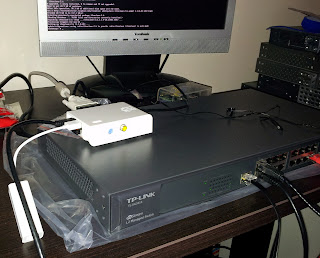A quick guide to setting up a IPv6 Tunnel using public 6to4 relays under GNU/Linux
Setting up a 6to4 tunnel will allow IPv6 (or dualstack) hosts on networks that only have Public IPv4 addresses to access sites and services that are available via IPv6. The main steps are calculating the IPv6 version of your Public IPv4 address; establishing a 6to4 tunnel to one of the free IPv6 relays available; and configuring the local network to route IPv6 via the tunnel.
Overview of the Topology
Calculate IPv6 version of Public IP and Setup 6to4 tunnel
Calculate the 6to4 prefix (/48) of your Public
IPv4 Address (http://checkip.dyndns.org) using WYAE's IPv6 Tunnel Calculator at http://www.wyae.de/docs/ipv6calc/
Alternatively, calculate the prefix from a Bash prompt, as below:
# printf "2002:%02x%02x:%02x%02x\n" `echo 123.187.233.132 | tr . ' '`
2002:7bbb:e984
Create the tunnel named '6to4' and allow any traffic
to leave via the IPv4 WAN address (the address of the network card
that is the next hop towards the Internet, 192.168.0.17 in the below example):
#
ip tunnel add 6to4 mode sit remote any local 192.168.0.17
Bring
up the tunnel:
#
ip link set 6to4 up
Assign
an IPv6 address to the tunnel interface, beginning with the prefix calculated
earlier:
#
ip addr add 2002:7bbb:e984::1/16 dev 6to4
Set the default IPv6 route to use the standard 6to4 Anycast address:
#
ip -6 route add default via ::192.88.99.1 dev 6to4
Enable IPv6 routing
Enable forwarding:
#
echo 1 > /proc/sys/net/ipv6/conf/all/forwarding
Install radvd (Router
Advertisement Daemon) if not present:
#
apt-get install radvd
Add an entry for your LAN interface to /etc/radvd.conf
(use /64 prefix made up of combination of public IPv6 + padding. eg:
'f00d' as below)
interface
eth1 {
AdvSendAdvert
on;
prefix 2002:7bbb:e984:f00d::/64 {
AdvOnLink
on;
AdvAutonomous
on;
};
};
Assign an address in the range
specified in prefix to the LAN adaptor (eg: 2002:7bbb:e984:f00d::1/64) by setting in /etc/network/interfaces:
allow-hotplug
eth1
iface
eth1 inet6 static
address
2002:7bbb:e984:f00d::1
netmask
64
Start radvd:
#
/etc/init.d/radvd start
On a client, bring up the network
interface:
#
ip link set dev eth3 up
radvd should have assigned it an
address starting with the prefix specified in radvd.conf. Check the
address, paying attention to the address shown in the global
scope:
#
ip -6 addr show dev eth3
2:
eth3: <BROADCAST,MULTICAST,UP,LOWER_UP> mtu 1500 qlen 1000
inet6 2002:7bbb:e984:f00d:a00:27ff:fe37:a19c/64 scope global dynamic
valid_lft
85969sec preferred_lft 13969sec
inet6
fe80::a00:27ff:fe37:a19c/64 scope link
valid_lft
forever preferred_lft forever
DNS Resolution
Modify /etc/resolv.conf
to use Google's free IPv6 servers:
nameserver
2001:4860:4860::8888
nameserver
2001:4860:4860::8844
Testing
Show neighbors on the radvd router
#
ip -6 neigh show
2002:7bbb:e984:f00d:a00:27ff:fe37:a19c
dev eth1 lladdr 08:00:27:37:a1:9c REACHABLE
Show neighbors on the autoconfigured client
#
ip -6 neigh show
fe80::a00:27ff:fe87:9124
dev eth3 lladdr 08:00:27:87:91:24 router STALE
2002:7bbb:e984:f00d::1
dev eth3 lladdr 08:00:27:87:91:24 REACHABLE
Show address of the interface:
#
ip -6 addr show dev eth3
2:
eth3: <BROADCAST,MULTICAST,UP,LOWER_UP> mtu 1500 qlen 1000
inet6 2002:7bbb:e984:f00d:a00:27ff:fe37:a19c/64 scope global dynamic
valid_lft
86359sec preferred_lft 14359sec
inet6
fe80::a00:27ff:fe37:a19c/64 scope link
valid_lft
forever preferred_lft forever
Optionally, on the client: manually add the radvd router as the default gateway:
#
ip -6 route add default via 2002:7bbb:e984:f00d::1
#
ip -6 route show
2002:7bbb:e984:f00d::/64
dev eth3 proto kernel metric 256 expires 86187sec mtu 1500 advmss
1440 hoplimit 4294967295
fe80::/64
dev eth3 proto kernel metric 256 mtu 1500 advmss 1440 hoplimit
4294967295
default
via fe80::a00:27ff:fe87:9124 dev eth3 proto kernel metric 1024
expires 1581sec mtu 1500 advmss 1440 hoplimit 64
default
via 2002:7bbb:e984:f00d::1 dev eth3 metric 1024 mtu 1500 advmss
1440 hoplimit 4294967295
Test by pinging Google's DNS server. Use ping6 rather than ping.
#
ping6 2001:4860:4860::8888
PING
2001:4860:4860::8888(2001:4860:4860::8888) 56 data bytes
64
bytes from 2001:4860:4860::8888: icmp_seq=1 ttl=56 time=299 ms
64
bytes from 2001:4860:4860::8888: icmp_seq=2 ttl=56 time=298 ms
64
bytes from 2001:4860:4860::8888: icmp_seq=3 ttl=56 time=297 ms
^C
---
2001:4860:4860::8888 ping statistics ---
3
packets transmitted, 3 received, 0% packet loss, time 2002ms
rtt
min/avg/max/mdev = 297.606/298.244/299.020/0.585 ms
Ping Google's IPv6 site:
#
ping6 ipv6.google.com
PING
ipv6.google.com(fra07s07-in-x69.1e100.net) 56 data bytes
64
bytes from fra07s07-in-x69.1e100.net: icmp_seq=1 ttl=58 time=431 ms
^C
---
ipv6.google.com ping statistics ---
2
packets transmitted, 1 received, 50% packet loss, time 1000ms
rtt
min/avg/max/mdev = 431.460/431.460/431.460/0.000 ms
Test web access with lynx:
Example Bash script to automatically configure 6to4 tunnel and update radvd.conf
(requires that lynx be
installed and obviously needs to be modified to reflect different interfaces, etc.)
#!/bin/bash
#
find WAN address
WAN_ADDR=`ifconfig
eth0 | grep inet\ addr | awk -F: '{ print $2 }' | awk '{ print $1 }'`
echo
"WAN Address: $WAN_ADDR"
#
find public IP address
/usr/bin/lynx
-dump http://checkip.dyndns.org > /tmp/public-ip.txt
PUBLIC_IPv4=`cat
/tmp/public-ip.txt | grep Addr | awk '{print $4}'`
export
PUBLIC_IPv4
echo
"Public IPv4 address: $PUBLIC_IPv4"
#
convert public IP address to create IPv6 prefix
PUBLIC_IPv6=`printf
"2002:%02x%02x:%02x%02x\n" \`echo $PUBLIC_IPv4 | tr . '
'\``
export
PUBLIC_IPv6
echo
"Public IPv6 prefix: $PUBLIC_IPv6"
echo
1 > /proc/sys/net/ipv6/conf/all/forwarding
#
create the tunnel and allow any traffic to leave via the WAN address
ip
tunnel add 6to4 mode sit remote any local $WAN_ADDR
#
bring up the tunnel
ip
link set 6to4 up
#
add the converted public IP to the tunnel
ip
addr add $PUBLIC_IPv6::1/16 dev 6to4
#
route all IPv6 traffic to the 6to4 converter via the tunnel
ip
-6 route add default via ::192.88.99.1 dev 6to4
#
add dns servers to resolv.conf
echo
"
nameserver
2001:4860:4860::8888
nameserver
2001:4860:4860::8844
"
> /etc/resolv.conf
#
update radvd.conf
cp
/etc/radvd.conf /tmp/radvd.conf.BAK
echo
"interface eth1 {
AdvSendAdvert
on;
prefix
$PUBLIC_IPv6:f00d::/64 {
AdvOnLink
on;
AdvAutonomous
on;
};
};"
> /etc/radvd.conf
#
restart radvd
/etc/init.d/radvd
restart





Comments
Post a Comment